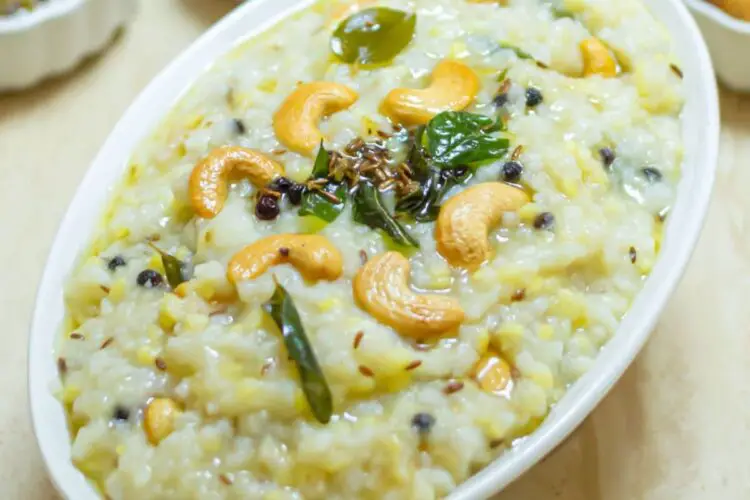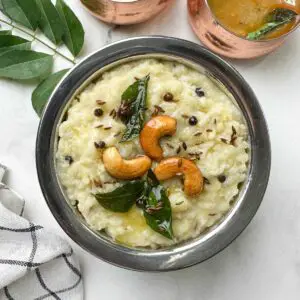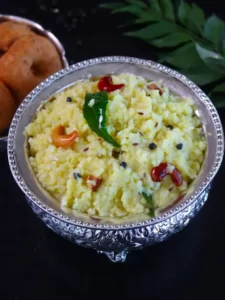Pongal is a traditional South Indian dish that is typically made during the festival of Pongal, which is celebrated in Tamil Nadu. It is a savory rice and lentil dish cooked with spices and usually garnished with ghee (clarified butter) and cashew nuts.
Pongal is a popular and traditional South Indian dish that originated in Tamil Nadu. It is both the name of the dish and a harvest festival celebrated in Tamil Nadu, usually in mid-January. The festival, also known as Thai Pongal, marks the beginning of the Tamil month of Thai and is a thanksgiving celebration for a bountiful harvest.
Overall, Pongal is a cherished dish and festival in Tamil Nadu, representing the rich cultural heritage and agricultural traditions of the region.
Here’s a recipe to make Pongal:
Ingredients:
- 1 cup raw rice
- 1/4 cup split yellow moong dal (lentils)
- 4 cups water
- 2 tablespoons ghee (clarified butter)
- 1/2 teaspoon cumin seeds
- 1/2 teaspoon whole black peppercorns
- 1/2 teaspoon grated ginger
- 8-10 cashew nuts
- A pinch of asafoetida (hing)
- 1/2 teaspoon turmeric powder
- Salt to taste
- Freshly chopped coriander leaves for garnishing
Instructions:
- Rinse the rice and moong dal under running water until the water runs clear. Drain and set aside.
- In a pressure cooker or a large pot, add the rinsed rice, moong dal, and 4 cups of water. Pressure cook for about 3-4 whistles or cook in a pot until the rice and dal are soft and well-cooked. Set aside.
- Heat ghee in a pan over medium heat. Add cumin seeds and black peppercorns. Sauté for a minute until they start to splutter.
- Add grated ginger, cashew nuts, and asafoetida to the pan. Sauté for a couple of minutes until the cashew nuts turn golden brown.
- Now, add the cooked rice and dal mixture to the pan and mix well with the spices and cashew nuts.
- Add turmeric powder and salt to the pan. Mix everything together until well combined. If the mixture looks dry, you can add a little more ghee.
- Cook the mixture for a few more minutes on low heat, stirring occasionally to prevent sticking. This will help the flavors to blend together.
- Once cooked, remove from heat and garnish with freshly chopped coriander leaves.
Your Pongal is now ready to be served! It is typically enjoyed hot with coconut chutney or sambar (a South Indian lentil soup).
Serving suggestion
- Pongal pairs well with coconut chutney, which is a popular accompaniment in South Indian cuisine. The cool and refreshing coconut chutney complements the flavors of pongal. Another delicious option is to serve with sambar, a flavorful lentil soup made with vegetables and spices. The combination of pongal and sambar creates a hearty and satisfying meal.
- To enhance the taste, you can garnish it with a drizzle of ghee (clarified butter) and some roasted cashew nuts. This adds richness and a delightful crunch to the dish. Pongal also pairs well with crispy medu vada, which are savory lentil fritters. The soft and creamy texture of pongal complements the crispy and savory vadas.
- Pongal can be enjoyed with a side of tangy and spicy pickles, such as mango pickle or lemon pickle. The contrasting flavors add an extra zing to the meal. You can also serve it with a side of plain yogurt or raita.
Tips and variations:
Tips:
- Rice and Lentils: Use good quality raw rice and split yellow moong dal for the best results. Rinse them well before cooking to remove any impurities.
- Water Ratio: The water ratio is important to get the right consistency of Pongal. For a soft and creamy texture, use approximately 4 cups of water for 1 cup of rice and 1/4 cup of dal.
- Seasoning: The seasoning plays a crucial role in the flavor of Pongal. Sautéing the spices like cumin seeds, black peppercorns, and ginger in ghee before adding them to the dish helps release their flavors.
- Ghee: Traditionally, Pongal is prepared with ghee, which adds a rich and buttery taste. If you prefer a lighter version, you can use a combination of ghee and oil or use only oil.
- Roasted Cashews: Roasting the cashew nuts in ghee until golden brown adds a delicious nutty flavor and crunch to the Pongal. Make sure to keep an eye on them while roasting to prevent burning.
Variations:
- Vegetable: Add a variety of finely chopped vegetables like carrots, beans, peas, and capsicum to make it a more nutritious and colorful dish. Sauté the vegetables along with the spices before adding the rice and dal mixture.
- Millet: Substitute the rice with millets like foxtail millet, barnyard millet, or quinoa to make a healthier version of Pongal. Adjust the cooking time and water ratio accordingly.
- Sweet: Pongal can also be made in a sweet version known as Sakkarai Pongal. In this variation, jaggery (or sugar), ghee, and roasted cashews are added to cooked rice and moong dal, creating a delightfully sweet treat.
- Coconut: To add a touch of coconut flavor, you can include grated coconut or coconut milk while cooking the rice and dal. The coconut adds a creamy texture and subtle sweetness to the dish.
FAQs
- Q: Can I use any type of rice?
A: Traditionally, raw rice is used. You can use short-grain or medium-grain rice like Sona Masoori or Ponni rice. However, you can also experiment with other types of rice, such as basmati or jasmine rice, for slightly different flavors and textures.
- Q: Can I make Pongal without a pressure cooker?
A: Yes, you can cook Pongal in a regular pot on the stovetop. Soak the rice and dal for about 30 minutes before cooking, then cook them together with water in a pot until they are soft and well-cooked. It may take a little longer compared to using a pressure cooker.
- Q: Can I make Pongal in advance?
A: It is best enjoyed fresh and hot. However, you can make it in advance and store it in the refrigerator for up to 2 days. When reheating, add a little water or milk and gently heat it on the stovetop to restore the desired consistency.
- Q: Can I adjust the spices?
A: Yes, you can adjust the spices according to your taste preferences. If you prefer a milder flavor, reduce the amount of black peppercorns or skip them altogether. Similarly, you can increase or decrease the amount of ginger and other spices to suit your taste.
- Q: Can I make Pongal vegan?
A: Yes, it can be made vegan-friendly by using vegetable oil instead of ghee and skipping the cashew nuts or substituting them with other nuts or seeds of your choice. The dish will still be delicious and flavorful.
Nutritions
| Calories | 82 kcal |
| Fat | 5 g |
| Carbohydrates | 60 g |
| Sodium | 139 mg |
| Potassium | 7 mg |
| Protein | 1 g |
| Vitamin A | 25 IU |
| Calcium | 15 mg |
| Vitamin C | 0.1 mg |
| Iron | 0.5 mg |
Also, read:
- Chicken Momos Recipe (step by step)
- Paneer do pyaza recipe
- how to make paneer butter masala
- Palak Paneer Recipe
- Paneer Dum Biryani Recipe



